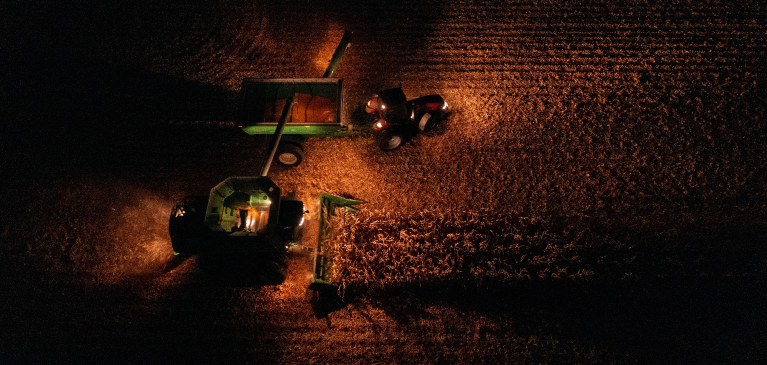
Predictions for Michigan and Wisconsin state average corn yields are expected to be below last year’s outstanding year, still above state five-year averages.
Wisconsin farmers had a cool and wet spring, which delayed planting, but they’ve had mostly favorable weather conditions including timely rains to break a dry month of July.
According to the most recent USDA NASS Crop Production report, Sept 1, Wisconsin is expected to harvest an average of 183 bushels per acre, which is a record for the state – up three bushels from last year.
The national corn estimate as of Aug. 1 was 175.4 bushels per acre, but was inched lower in USDA’s Sept. 1 report to an average 172.5 bushels per harvested acre, down 4.5 bushels from last year.
Total Wisconsin corn production is forecast at 539.9 million bushels, down from last year’s 547.2 million bushels
In Michigan, yield declines were attributed to spring planting delays due to cold, wet conditions, and drier-than-normal growing conditions, which were not followed by Wisconsin’s timely rains. The drought conditions were particularly prevalent in Central Michigan and the Thumb regions. USDA corn predictions for Michigan dropped from 170 bushels per acre in August to 168 in September. Overall, the estimated corn production drops from 346.9 million bushels last year to 330.9 million bushels in 2022.
Between the Rows outlook
This year, with the help of Nutrien Ag Solution’s summer interns, 368 corn fields across 37 counties in Michigan’s lower peninsula were assessed for yield. The Corn Marketing Program of Michigan’s statewide yield estimate of 178 bushels per acre is weighted by county corn production to be more accurate.
Corn yields were highly variable across the state, with county averages ranging from 126 bushels per acre in Montcalm County to 220 bushels per acre in Tuscola County.
Kristin Poley, research manager for the Corn Marketing Program of Michigan attributes this variability in corn quality and yield to the weather, saying “The effects of the hot, dry weather experienced by most producers throughout the growing season is evident in pollination issues and high incidence of tip back on ears (where the end of the ear doesn't get fully developed) across the state.”
John Grassley, vice president of agribusiness lending for GreenStone Farm Credit Services, says the tip back can also be tied to nutrient deficiency. “After everything was planted, it was really dry for a long time. And then we got the rains. It could be tied to that because fertilizer sat out there for a long time before there was anything to get it activated,” said Grassley.
Growers are reporting that tar spot is not likely to have a large impact on yield projections this year, primarily due to weather conditions not being conducive to the disease’s growth and spread.
Dennis Gardner, who is farming about 2,400 acres – 900 acres soybeans, 350 acres of corn, 300 acres of wheat and about 600 acres of sobyeans – including some custom work in Michigan’s Yale/Croswell area, says he expects his corn to yield somewhere in the 180-to-190 range, down from the 2021 farm average of just over 200 bushels per acres.
Soybean predictions
Gardner was just finishing up his soybeans Oct. 10 on his farm about 10 miles from Lake Huron.
“We were wet early on, and then got a window to get things planted – from that point forward we were begging for moisture,” he says. “We’ve been on the dryer side all year, so we expect to be about 10 bushels less than last year. I did a yield average on Oct. 8 and got 62 bushels per acre. We did better on some of my heavier ground, but on the lighter, sandier soil the yield wasn't as good.”
Statewide, Grassley says he thinks growers are optimistic for soybeans and most are expecting an average corn crop.
“There’s a lot of variability out there,” he says. “Soybeans are maybe a little drier than what they expected. And, as corn harvest is just getting underway, some growers are finding it a little wetter than anticipated, as it’s a little further behind the average maturity.”
Gardner says his goal every year is to be done before deer season, Nov. 15. “Because everyone knows that's a national holiday,” he says. “Corn is pretty dry here, so I expect it to come off pretty quickly.”
Wisconsin Soybean yield improved slightly from USDA’s August 1 prediction of 52 bushels per acre (bpa) to 53 bpa in September, but still just short of last year’s 55 bpa. Total production is forecast at 112.8 million bushels, down from 113.8 million bushels the previous year.
Michigan expects to have an average harvest of 47 bushels per acres, down from last year’s 51 bpa. Total Michigan soybean production is forecast at 104.8 million bushels, down from last year’s 109.1 million bushels.
U.S. production for beans is forecast at 4.38 billion bushels, down 3 percent from the previous forecast and down 1 percent from 2021. Based on conditions as of September 1, yields are expected to average 50.5 bushels per acre, down 1.4 bushels from the previous forecast and down 0.9 bushel from 2021.
Tags
Request for Information| Apply Now| Farm Operating


